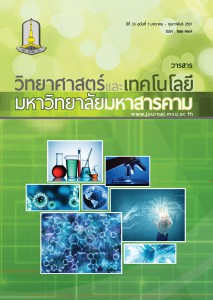ปริมาณสาร Phorbol-12-myristate-13-acetate (PMA) ในลูกสลอดก่อนและหลังการแปรสภาพด้วยวิธีการทางการแพทย์แผนไทย
Main Article Content
Abstract
บทคัดย่อ
สลอดเป็นพืชที่มีฤทธิ์ทางชีวภาพหลายชนิด เช่น ฤทธิ์ต้านมะเร็ง ลดความดันโลหิตสูง คลายกล้ามเนื้อเรียบ ต้านเชื้อแบคทีเรียเชื้อรา และยีสต์ กระตุ้นระบบภูมิคุ้มกัน ลูกสลอดมีฤทธิ์เป็นยาถ่ายอย่างแรง รวมถึงมีองค์ประกอบทางเคมีบางชนิดที่มีความเป็นพิษ เช่น Phorbol-12-myristate-13-acetate (PMA) สลอดถูกประกาศให้เป็นยาอันตราย ห้ามใช้ตั้งแต่ปี พ.ศ. 2519 แต่ก็พบว่าลูกสลอดเป็นส่วนประกอบในตำรับยาแผนไทยหลายตำรับมานานแล้ว ซึ่งลูกสลอดที่นำมาใช้ทางการแพทย์แผนไทยจะต้องผ่านการแปรสภาพเสียก่อน โดยเชื่อว่าการแปรสภาพจะช่วยลดความเป็นพิษและผลข้างเคียงของสลอดได้ การวิจัยในครั้งนี้มีวัตถุประสงค์เพื่อพิสูจน์วิธีการแปรสภาพลูกสลอด 4 วิธี คือ วิธีที่ 1 นำเมล็ดลูกสลอดใส่ในหม้อดิน เติมข้าวเปลือก เกลือและนํ้า ต้มจนข้าวเปลือกบานทั่วกัน วิธีที่ 2 นำเมล็ดลูกสลอดผสมกับใบมะขาม ใบส้มป่อย ใส่ในหม้อดิน เติมนํ้าและต้มจนเดือดวิธีที่ 3 นำเมล็ดลูกสลอดแช่นํ้าปลาร้าปากไหไว้ 1 คืน แล้วเอายัดใส่ในผลมะกรูด ใส่หม้อดินปิดฝา สุมด้วยไฟแกลบ วิธีที่ 4นำเมล็ดลูกสลอดตำให้ละเอียด คั่วให้เกรียมจนหมดนํ้ามัน(1-3) โดยการเปรียบเทียบปริมาณของ PMA และองค์ประกอบทางเคมีอื่นๆในลูกสลอดก่อนและหลังการแปรสภาพ ด้วยวิธีโครมาโตกราฟีของเหลวสมรรถนะสูง (HPLC) ผลการศึกษาพบว่าปริมาณของPMA ในลูกสลอดก่อนและหลังการแปรสภาพทุกวิธีแตกต่างกันอย่างมีนัยสำคัญทางสถิติ (P<0.05) โดยปริมาณ PMA หลังจากการแปรสภาพด้วยวิธีที่ 1, 3 และ 4 ลดลงร้อยละ 44.47, 7.33, 79.76 ตามลำดับ แต่วิธีที่ 2 ทำให้ปริมาณ PMA เพิ่มขึ้น ร้อยละ13.91 โดยวิธีที่ 4 เป็นวิธีที่สามารถลดปริมาณ PMA ได้มากที่สุด
คำสำคัญ: phorbol-12-myristate-13-acetate (PMA) การแปรสภาพ การแพทย์แผนไทย ลูกสลอด
Abstract
Croton tiglium Linn has been found to possess a variety of beneficial biological activities including anti-cancer,reduction of blood pressure, smooth muscle relaxant, anti-bacteria, fungi and yeast, and immune stimulation. The seedof C. tiglium is a powerful drastic purgative, and some chemical constituents are toxic, such as phorbol-12-myristate-13-acetate (PMA). C. tiglium has not been allowed to be used as medicine in Thailand since 1976, however it has been used in many Thai traditional preparations for a long time. The seed of C. tiglium must be treated by one of many methods in Thai traditional medicine before use. Those methods claimed to reduce toxicity and side effect of C. tiglium. The objective of this report was to scientifically prove 4 treatment methods of C. tiglium. Method 1: The C. tiglium seeds were mixed with unpeeled rice and salt then boiled in a clay pot. Method 2: The C. tiglium seeds were mixed with tamarind leaf and Acacia concinna leaf then boiled in a clay pot. Method 3: The C. tiglium seeds were soaked in fermented fish sauce (Nam-pla-raa) overnight after that the seeds were put in the Leech lime fruits and boiled in aclay pot. Method 4: The C. tiglium seeds were ground to fi ne powder and roasted in a pan.(1-3) The amounts of PMA in C. tiglium before and after treatment by 4 methods were determined by HPLC and compared. Results showed that amounts of PMA in the C. tiglium seeds before and after treatment in all methods were significantly different (P<0.05).The amount of PMA after treatment by method 1, 3 and 4 were decreased 44.47, 7.33, 79.76 %, respectively but that treated by method 2 was increased (13.91%). Method 4 showed the most decrease in the amount of PMA.
Keywords: phorbol-12-myristate-13-acetate (PMA), treatment, Thai traditional medicine, Croton tiglium


